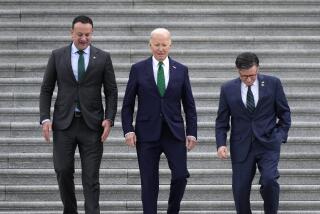Money Supply Climbs $600 Million
- Share via
NEW YORK — The nation’s basic money supply rose by $600 million in late August, the Federal Reserve Board reported Thursday.
The rise was much less than anticipated, but even so, analysts said it had a slightly negative effect on credit markets.
The Fed said M1 rose to a seasonally adjusted average of $688.6 billion in the week ended Aug. 25 from a revised $688 billion in the previous week. M1 includes cash in circulation, deposits in checking accounts and non-bank travelers checks.
For the latest 13 weeks, M1 averaged $675.1 billion, a 17.9% seasonally adjusted annual rate of gain from the previous 13 weeks.
The Fed, in its attempt to provide enough money to stimulate non-inflationary economic growth, has said it would like to see M1 grow in a range of 3% to 8% from the fourth quarter of 1985 through the final quarter of 1986.
But in July it announced that it was de-emphasizing the role of M1 in setting credit policy. Declaring that it would be looking more at broader measures, it said above-target M1 growth “would be acceptable.”
On an annual basis, M1 is currently growing at an estimated rate of 15.2%.
In advance of the money report, a nationwide survey of 37 economists by Money Market Services of Belmont, Calif., showed that the median estimate of monetary growth for the week was $2.2 billion, far above the actual $600-million figure announced Thursday.
In the credit markets, which lately have been unnerved by fears of resurgent inflation, interest rates and bond prices fell slightly after the new money supply statistics were announced.
Far Above Target Range
“The reality is that we’re far, far above--about $30 billion above--the Fed’s target upper limit of monetary growth range,” said David Jones, an economist at Aubrey G. Lanston & Co.
So even though the latest figures were less than the market had expected, “at a time when the market is beginning to focus on renewed inflation, the money supply figures take on more significance,” he said.
Ray Stone, an analyst at Merrill Lynch Capital Markets, also blamed inflation jitters for the continuing erosion of bond prices after the M1 figures were released.
“If you had a position and were looking for a reason to sell it, and if the market did not move up (when the better-than-expected figures on the money supply were announced), you sold it anyway,” he said.
In other reports:
- The Federal Reserve Bank of New York reported that commercial and industrial loans at major New York City banks rose $955 million in the week ended Aug. 27, compared to a decline of $239 million a week earlier.
- The Federal Reserve said bank borrowings from the Federal Reserve System averaged $395 billion in the two-week period ended Aug. 27, up from $386 million in the previous two-week period.
- The Federal Reserve said total adjusted reserves of member banks averaged $51.66 billion in the two weeks, up from $50.83 billion in the earlier period.
- The Federal Reserve said free reserves totaled $488 million in the two weeks ended Aug. 27, up from $201 million a week earlier.
- The Federal Reserve Bank of St. Louis reported that the monetary base, the seasonally adjusted total of member bank reserves held at Federal Reserve banks and cash in bank vaults and in circulation, was $247.2 billion in the two-week period ended Aug. 27, up from $246.1 billion two weeks earlier.
More to Read
Inside the business of entertainment
The Wide Shot brings you news, analysis and insights on everything from streaming wars to production — and what it all means for the future.
You may occasionally receive promotional content from the Los Angeles Times.










